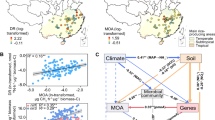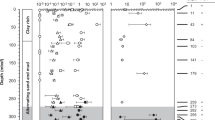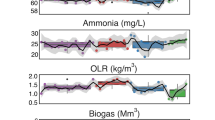Abstract
Little is known about population dynamics and contribution of specific taxa to methane oxidation in flooded rice paddies. In this article we investigate the succession of methanotrophs in oxygen–methane counter-gradients. We used a gradient microcosm system that simulates oxic–anoxic interfaces of a water-saturated paddy soils, and measured pmoA-based (gene encoding particulate methane monooxygenase) terminal restriction fragment length polymorphism (T-RFLP) profiles at both the transcription (mRNA) and the population (DNA) levels. The DNA T-RFLP profiles indicated that the methanotrophic community present clearly differed from the active methanotrophic community. We observed a succession of the methanotrophic community over time without any direct effect of pore water chemistry on the community structure. Both the total population and the active subpopulation changed with time, whereas methane oxidation rates remained nearly constant. Hence, we suggest that a diverse microbial seed bank of methanotrophs is important in maintaining the function in a dynamic ecosystem.
Similar content being viewed by others
Log in or create a free account to read this content
Gain free access to this article, as well as selected content from this journal and more on nature.com
or
References
Andrews JH, Harris RF . (1986). r-selection and K-selection and microbial ecology. Adv Microb Ecol 9: 99–147.
Bodelier PLE, Roslev P, Henckel T, Frenzel P . (2000). Stimulation by ammonium-based fertilizers of methane oxidation in soil around rice roots. Nature 403: 421–424.
Bodrossy L, Stralis-Pavese N, Murrell JC, Radajewski S, Weilharter A, Sessitsch A . (2003). Development and validation of a diagnostic microbial microarray for methanotrophs. Environ Microbiol 5: 566–582.
Bosse U, Frenzel P . (1997). Activity and distribution of methane-oxidizing bacteria in flooded rice soil microcosms and in rice plants (Oryza sativa). Appl Environ Microbiol 63: 1199–1207.
Bourne DG, McDonald IR, Murrell JC . (2001). Comparison of pmoA PCR primer sets as tools for investigating methanotroph diversity in three Danish soils. Appl Environ Microbiol 67: 3802–3809.
Bowman J . (2006). The methanotrophs—the families Methylococcaceae and Methylocystaceae. In: Dworkin M, Falkow S, Rosenberg E, Schleifer KH, Strackebrandt E. (eds). The Prokaryotes. Springer: New York. pp 266–289.
Bowman JP, Sly LI, Nichols PD, Hayward AC . (1993). Revised taxonomy of the methanotrophs: description of Methylobacter gen. nov., validation of Methylosinus and Methylocystis species, and a proposal that the family Methylococcaceae includes only the group I methanotrophs. Int J Syst Bacteriol 43: 735–753.
Conrad R . (2007). Microbial ecology of methanogens and methanotrophs. In: Donald LS (ed). Adv Agron. Academic Press. pp 1–63.
Conrad R . (2009). The global methane cycle: recent advances in understanding the microbial processes involved. Environ Microbiol 1: 279–284.
Conrad R, Rothfuss F . (1991). Methane oxidation in the soil surface layer of a flooded ride field and the effect of ammonium. Biol Fertil Soils 12: 28–32.
Costello AM, Lidstrom ME . (1999). Molecular characterization of functional and phylogenetic genes from natural populations of methanotrophs in lake sediments. Appl Environ Microbiol 65: 5066–5074.
Denman KL, Brasseur G, Chidthaisong A, Ciais P, Cox PM, Dickinson RE et al. (2007). Couplings between changes in the climate system and biogeochemistry. In: Solomon S, Qin D, Maning M, Chen Z, Marquis M, Averyt KB et al. (eds). Climate Change 2007: The Physical Science Basis. Contribution of Working Group I to the Fourth Assessment Report of the Intergovernmental Panel on Climate Change. Cambridge University Press: Cambridge, UK and New York. pp 500–587.
Dunfield PF, Yuryev A, Senin P, Smirnova AV, Stott MB, Hou SB et al. (2007). Methane oxidation by an extremely acidophilic bacterium of the phylum Verrucomicrobia. Nature 450: 879–882.
Eller G, Frenzel P . (2001). Changes in activity and community structure of methane oxidizing bacteria over the growth period of rice. Appl Environ Microbiol 67: 2395–2403.
Eller G, Krüger M, Frenzel P . (2005). Comparing field and microcosm experiments: a case study on methano- and methylotrophic bacteria in paddy soil. FEMS Microbiol Ecol 51: 279–291.
Graham DW, Chaudhary JA, Hanson RS, Arnold RG . (1993). Factors affecting competition between type I and type II methanotrophs in two-organism, continuous-flow reactors. Microb Ecol 25: 1–17.
Holmes AJ, Costello A, Lidstrom ME, Murrell JC . (1995). Evidence that particulate methane monooxygenase and ammonia monooxygenase may be evolutionarily related. FEMS Microbiol Lett 132: 203–208.
Islam T, Jensen S, Reigstad LJ, Larsen O, Birkeland NK . (2008). Methane oxidation at 55 °C and pH 2 by a thermoacidophilic bacterium belonging to the Verrucomicrobia phylum. Proc Natl Acad Sci USA 105: 300–304.
Lüke C, Krause S, Cavigiolo S, Greppi D, Lupotto E, Frenzel P . (2009). Biogeography of wetland rice methanotrophs. Environ Microbiol 12: 862–872.
McDonald IR, Murrell JC . (1997). The particulate methane monooxygenase gene pmoA and its use as a functional gene probe for methanotrophs. FEMS Microbiol Lett 156: 205–210.
Murase J, Frenzel P . (2007). A methane-driven microbial food web in a wetland rice soil. Environ Microbiol 9: 3025–3034.
Noll M, Frenzel P, Conrad R . (2008). Selective stimulation of type I methanotrophs in a rice paddy soil by urea fertilization revealed by RNA-based stable isotope probing. FEMS Microbiol Ecol 65: 125–132.
Noll M, Matthies D, Frenzel P, Derakshani M, Liesack W . (2005). Succession of bacterial community structure and diversity in a paddy soil oxygen gradient. Environ Microbiol 7: 382–395.
Pol A, Heijmans K, Harhangi HR, Tedesco D, Jetten MSM, op den Camp HJM . (2007). Methanotrophy below pH1 by a new Verrucomicrobia species. Nature 450: 874–878.
Rothfuss F, Bender M, Conrad R . (1997). Survival and activity of bacteria in a deep, aged lake sediment (Lake Constance). Microb Ecol 33: 69–77.
Steenbergh AK, Meima MM, Kamst M, Bodelier PLE . (2009). Biphasic kinetics of a methanotrophic community is a combination of growth and increased activity per cell. FEMS Microbiol Ecol 71: 12–22.
Theisen AR, Ali MH, Radajewski S, Dumont MG, Dunfield PF, McDonald IR et al. (2005). Regulation of methane oxidation in the facultative methanotroph Methylocella silvestris BL2. Mol Microbiol 58: 682–692.
Whittenbury R, Davies SL, Davey JF . (1970). Exospores and cysts formed by methane-utilizing bacteria. J Gen Microbiol 61: 219–226.
Acknowledgements
We thank the CRA—Agricultural Research Council, Rice Research Unit—for support at the rice fields in Vercelli, Italy. We also thank Belinda Schneider and Alexandra Hahn for technical advice. The study was financially supported by a grant from the Deutsche Forschungsgemeinschaft (ESF and EuroDIVERSITY-METHECO).
Author information
Authors and Affiliations
Corresponding author
Additional information
Supplementary Information accompanies the paper on The ISME Journal website
Rights and permissions
About this article
Cite this article
Krause, S., Lüke, C. & Frenzel, P. Succession of methanotrophs in oxygen–methane counter-gradients of flooded rice paddies. ISME J 4, 1603–1607 (2010). https://doi.org/10.1038/ismej.2010.82
Received:
Revised:
Accepted:
Published:
Issue date:
DOI: https://doi.org/10.1038/ismej.2010.82
Keywords
This article is cited by
-
Seasonal Dynamics of Abundance, Structure, and Diversity of Methanogens and Methanotrophs in Lake Sediments
Microbial Ecology (2021)
-
The application of rapidly composted manure decreases paddy CH4 emission by adversely influencing methanogenic archaeal community: a greenhouse study
Journal of Soils and Sediments (2016)
-
Multi-scale phylogenetic heterogeneity of archaea, bacteria, methanogens and methanotrophs in lake sediments
Hydrobiologia (2015)
-
Linking activity, composition and seasonal dynamics of atmospheric methane oxidizers in a meadow soil
The ISME Journal (2012)
-
One millimetre makes the difference: high-resolution analysis of methane-oxidizing bacteria and their specific activity at the oxic–anoxic interface in a flooded paddy soil
The ISME Journal (2012)



